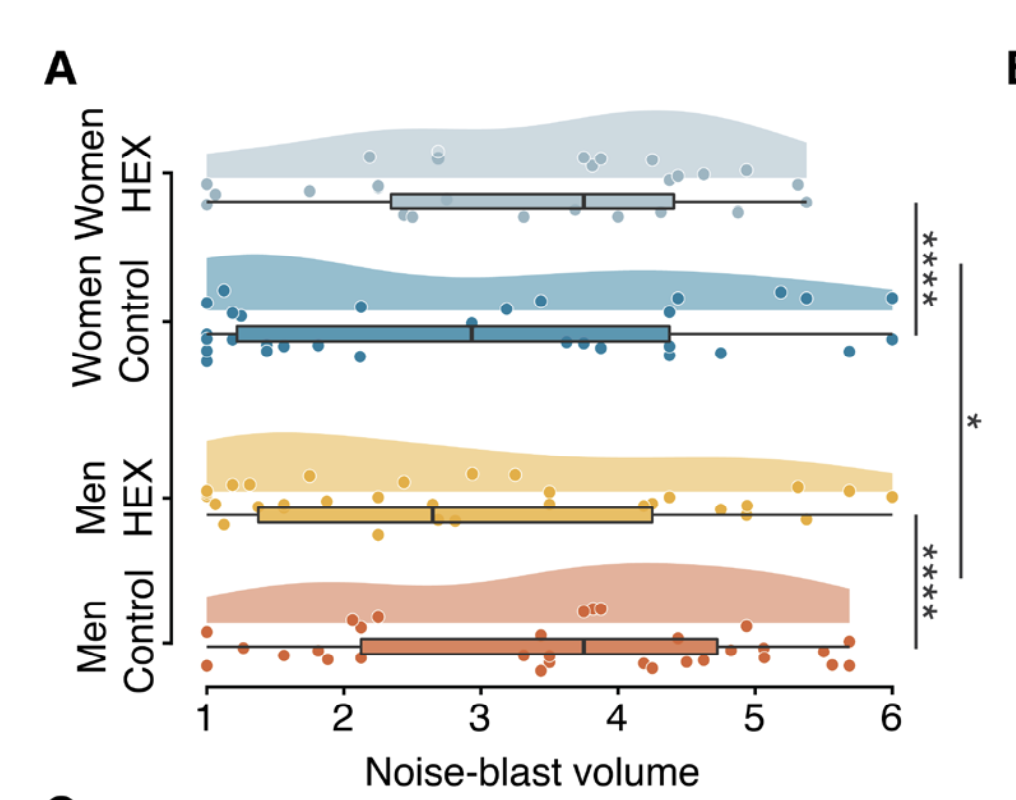Pheromones and aggression
 Pheromones are chemical cues that are released into the air, secreted from glands, or excreted in urine and picked up by animals of the same species, initiating various social and reproductive behaviours. Although the perfume industry may be interested in the role of pheromones in human attraction, psychologists are also interested in the potential role of human pheromones in human aggression and pro-social behaviour.
Pheromones are chemical cues that are released into the air, secreted from glands, or excreted in urine and picked up by animals of the same species, initiating various social and reproductive behaviours. Although the perfume industry may be interested in the role of pheromones in human attraction, psychologists are also interested in the potential role of human pheromones in human aggression and pro-social behaviour.
Pheromones and aggression
In the animal kingdom, animals will often attack members of their own species if they feel threatened. Males tend to do this to protect their territory and their mate. They will attack other males that invade their territory, but they will not attack other females or, in lab conditions, neutered males.
To definitively demonstrate that a pheromone exists, one must design a repeatable experiment, a bioassay, that shows that a smell molecule (odorant) causes a particular effect on the receiver. In this case, the effect would be an aggressive response. In order to test this in mice, Chamero et al (2007) attempted to isolate molecules found in mouse urine. They swabbed the backs of neutered male mice with various potential pheromone molecules and then introduced him as an intruder into the cage of a healthy male mouse. Using this technique, they were able to narrow it down to a protein that may be a pheromone that provokes aggressive behaviour.
But aggression in mice is very different from aggression in humans. Is there any chance that we also have an aggression-provoking pheromone?
How does one "smell" a pheromone?
 Pheromones seem to be detected by a structure called the vomeronasal organ, a tube at the base of the nasal cavity directly behind the nostrils that is filled with sensory neurons. It is found in most amphibians, reptiles, and nonprimate mammals, but is absent in birds and most primates. Surgical removal of the VNO eliminates territorial aggression and territorial marking in male mice and male hamsters.
Pheromones seem to be detected by a structure called the vomeronasal organ, a tube at the base of the nasal cavity directly behind the nostrils that is filled with sensory neurons. It is found in most amphibians, reptiles, and nonprimate mammals, but is absent in birds and most primates. Surgical removal of the VNO eliminates territorial aggression and territorial marking in male mice and male hamsters.
Humans do not have a functional VNO. If we have pheromones, how would they work?
The search for a human pheromone
It is a big question whether humans even have pheromones - and to date, no human pheromone has been definitively identified. However, Mishor et al (2021) may have found a putative pheromone.
Hexadecanal is a putative (potential) pheromone linked to human aggression. It is a molecule that is emitted from the heads of babies. It is, in fact, one of the most abundant molecules detected. Could this provoke aggressive behaviour from the baby's caretakers by acting as a pheromone?
Mishor et al (2021) carried out two experiments to test the effect of hexadecanal on both male and female behaviour.
In their first experiment, researchers used a volunteer sample of 67 men and 60 women (age range 21 - 34). The researchers used a double-blind independent samples design. Each participant wore a sticky pad pasted to their upper lip - one group was exposed to hexadecanal, and the other group to a placebo. The participants played computer games with a mysterious partner. The participants were not aware that this “partner” was actually a computer algorithm designed to provoke them.
In each round of the game, both players were allocated money that they could keep if they agreed on how to divide it between themselves. The "mysterious partner," however, never agreed if the participant would receive the greater sum. After five rounds, it was clear that the participant was being discriminated against in the game.
The participants then began the second half of the experiment. The participants were again deceived by believing that they were playing a computer game with the same "mysterious partner." They competed to identify a change in the shape of a target. The first person to react was then allowed to "blast" his/her opponent with a loud noise blast. The volume of the "blast" was how the researchers chose to operationalize aggression. The game was set up so that the participant "won" 16 out of 27 trials. They were then able to set the volume before blasting the mysterious partner.
Interpreting data
 The chart to the left shows the data collected by Mishor et al (2021) in their first experiment.
The chart to the left shows the data collected by Mishor et al (2021) in their first experiment.
What does this data representation tell us about the difference between the two conditions? What does it tell us about the difference between the two sexes?
The researchers found a small but consistent difference between the two groups. Women exposed to hexadecanal were more likely to "punish" the mysterious partner with severe noise blasts than women who had the placebo. On the other hand, men who were exposed to hexadecanal opted for less intense noise blasts than those who weren’t.
Mishor proposed that the emission of hexadecanal from babies provokes protective tendencies in mothers. However, how this mechanism actually works is not clear.
Critically thinking about research
 Concepts may be used to think critically about research. When evaluating the first experiment carried out by Mishor et al (2021), what would be the relevance of the following concepts?
Concepts may be used to think critically about research. When evaluating the first experiment carried out by Mishor et al (2021), what would be the relevance of the following concepts?
- Bias
- Causality
- Measurement
When discussing this first experiment, looking at the three concepts of bias, causality, and measurement is a way to get students to think about the strengths and limitations of the study on a deeper level than simply looking at aspects such as sample size.
Bias: The first experiment attempted to control for bias by using a double-blind control. Neither the researcher nor the participant knew which condition the participant was in. There was a potential sampling bias in that in both studies, a volunteer sample was used. These participants may have been more motivated and eager to please the researcher in the study. In addition, the sample could be biased for age. The age does correspond to the age of young parents, but it excludes people over the age of 34. I
Causality: The studies are highly controlled and this helps to establish a causal relationship between the IV (hexadecanal) and aggressive behaviour. Controls included counterbalancing to make sure that order effects in experiment 2 did not play a role. Otherwise, we might conclude that the longer they played, the more they got bored with the activity and did not make the same type of decisions, but that these decisions were not due to the pheromone itself. In addition, a placebo was used to make sure that it wasn't simply because they were receiving a treatment that their behaviour changed. Finally, in the second study, they use fresh air to avoid interference effects - that is, to make sure that the first scent is not in any way influencing the effect of the second scent. That all being said, the desire to establish causality means that ecological validity is compromised.
Measurement: There are a few concerns about measurement here. First, it is not clear how much of the odorant is naturally secreted by humans and whether the measure that was used is representative of human behaviour. In addition, the researchers used fMRI to measure "aggression." This is an indirect measure. Although the brain activity shows a pattern that warrants further investigation, the activity alone does not explain the relationship between hexadecanal and aggression. Finally, the tasks that are being done might not really be considered "aggression" in the same way that animals show aggression to protect their young. There is a question about the construct validity of the two studies.
Mishor et al (2021) carried out a second experiment with a sample of 25 men and 24 women. The goal was to determine how hexadecanal interacts with the brain to potentially cause aggression. In this study, the participants would play a computer game while in an fMRI where their computer opponent occasionally stole money from them. When this happened, they could choose to punish the mysterious partner by docking money from his/her account, without gaining any money themselves. The design was a repeated measures design with either hexadecanal, a placebo, or simply clean air being infused through the fMRI. The order of the conditions was counterbalanced.
Women showed more "punishment" activity than men when exposed to hexadecanal. In addition, the researchers observed a difference in activity in the left angular gyrus - a part of the brain responsible for interpreting social cues. Whereas men that were exposed to hexadecanal showed activity in the left angular gyrus synced with activity in brain areas involved in processing social information and aggression (such as the amygdala), women showed a decrease in activity.
Could this then mean that hexadecanal plays a role in women's protection of their infants?
The researchers used controls to increase the internal validity of the research and potentially identify a causal relationship. These included double-blind controls and counterbalancing.
Although the researchers attempt to make the link between the scent emitted from an infant and the protective behaviour of mothers, the experiments are highly artificial and do not reflect an infant/mother relationship.
It is not clear yet under what circumstances adults release hexadecanal or how humans would actually process the odorant.
The sample sizes of both studies are small. The results of the study would have to be replicated with larger samples in order to determine the reliability of the findings.
Although the fMRI shows some brain activity, it was not able to demonstrate how this activity would lead to aggressive behaviour.
- Generalizations from animal research have not proven to be valid.
- Human aggression is influenced by cognitive and sociocultural factors - including learned experience and social norms. It is a reductionist argument to propose that aggression can be attributed solely to pheromones.
- Studies on pheromones have often not been replicated. In addition, many of the studies are low in ecological validity.
- It is not possible to eliminate the effect of other variables that may influence human scent - eg. bacteria and diet.
- Humans do not appear to have a functional VNO which other animals use to detect pheromones. The human process of scent detection is very complex and difficult to study. The human scent is complex and made up of many different molecules. No one has yet mapped all of those molecules.

 IB Docs (2) Team
IB Docs (2) Team
